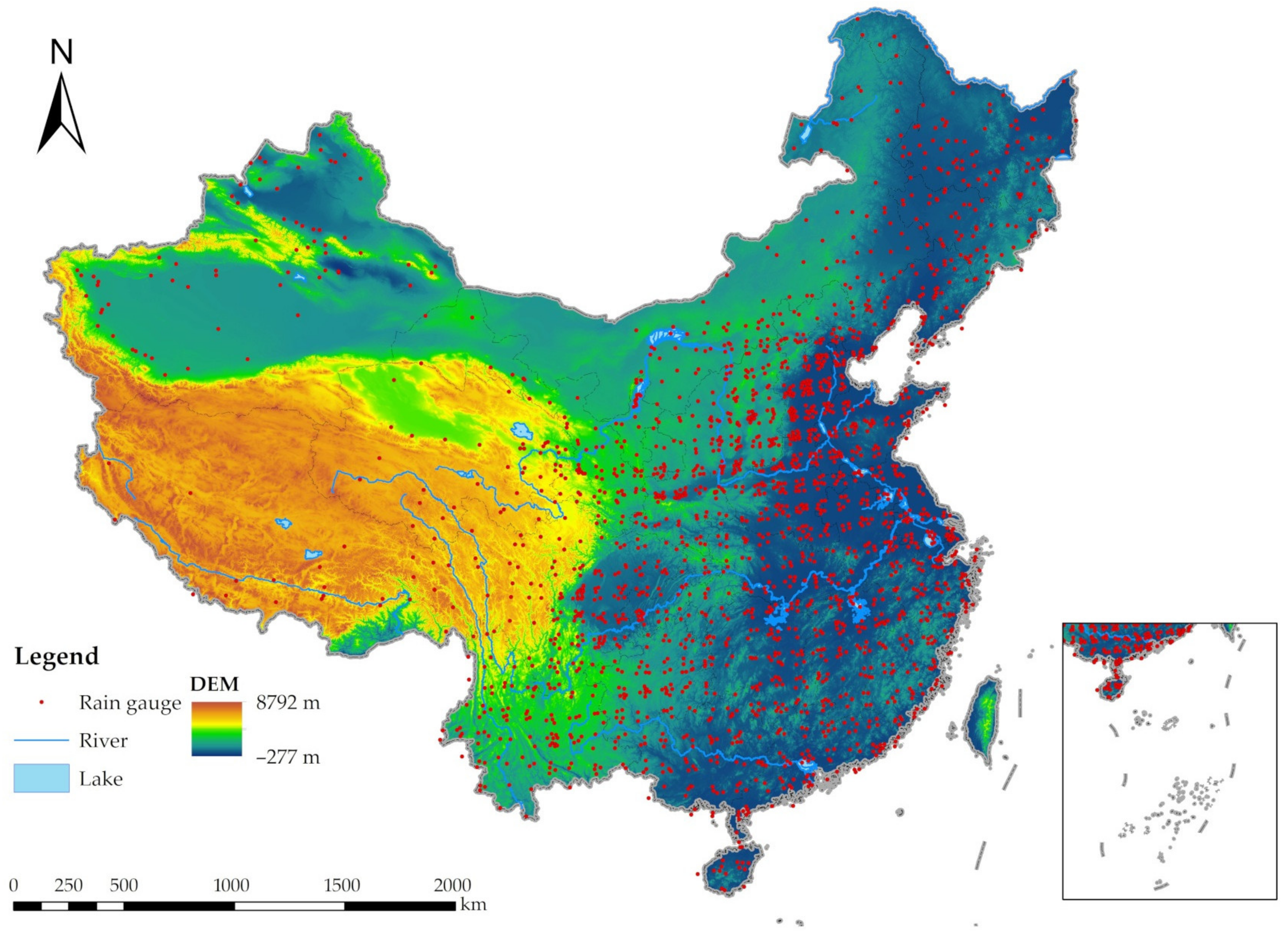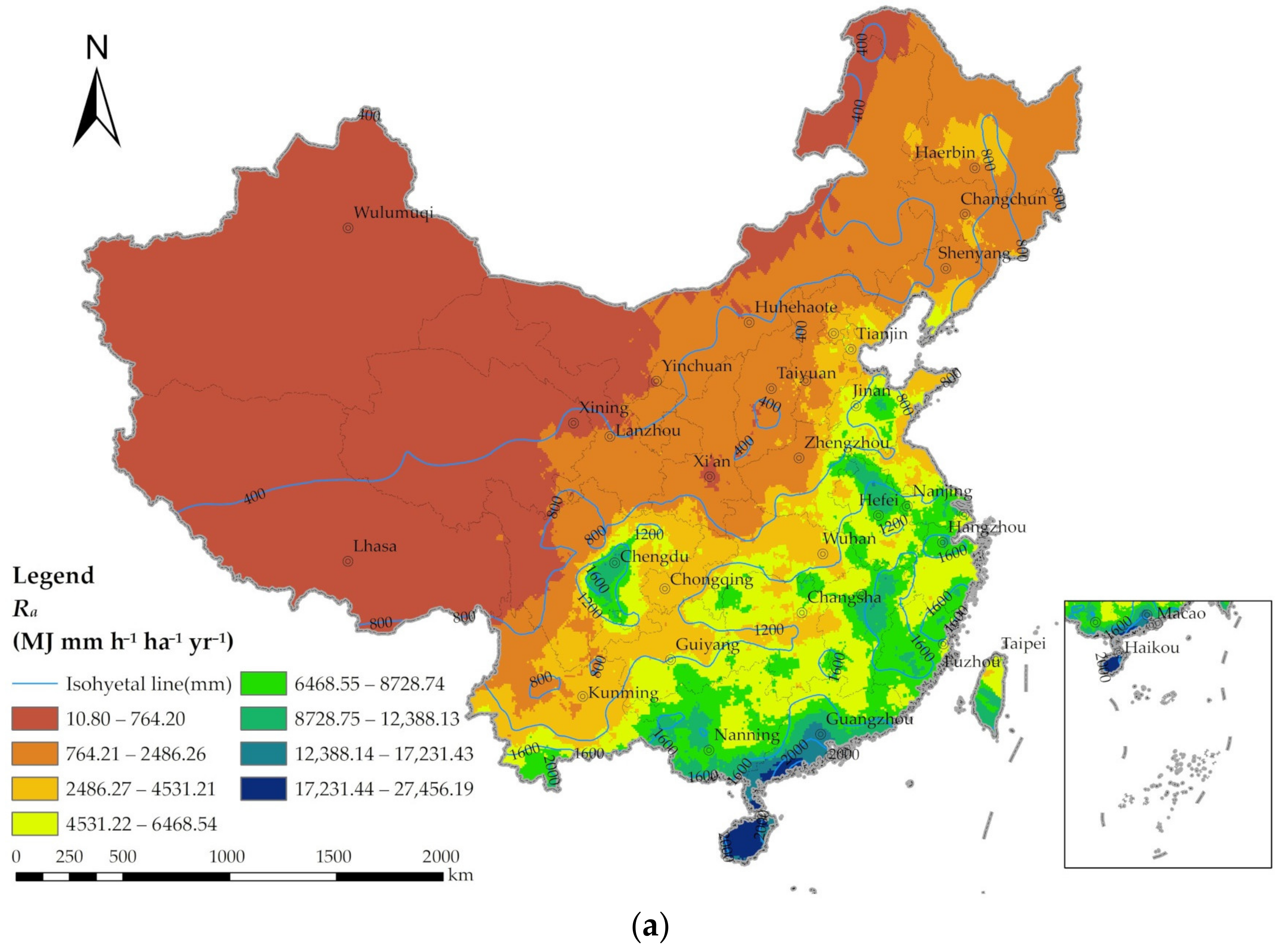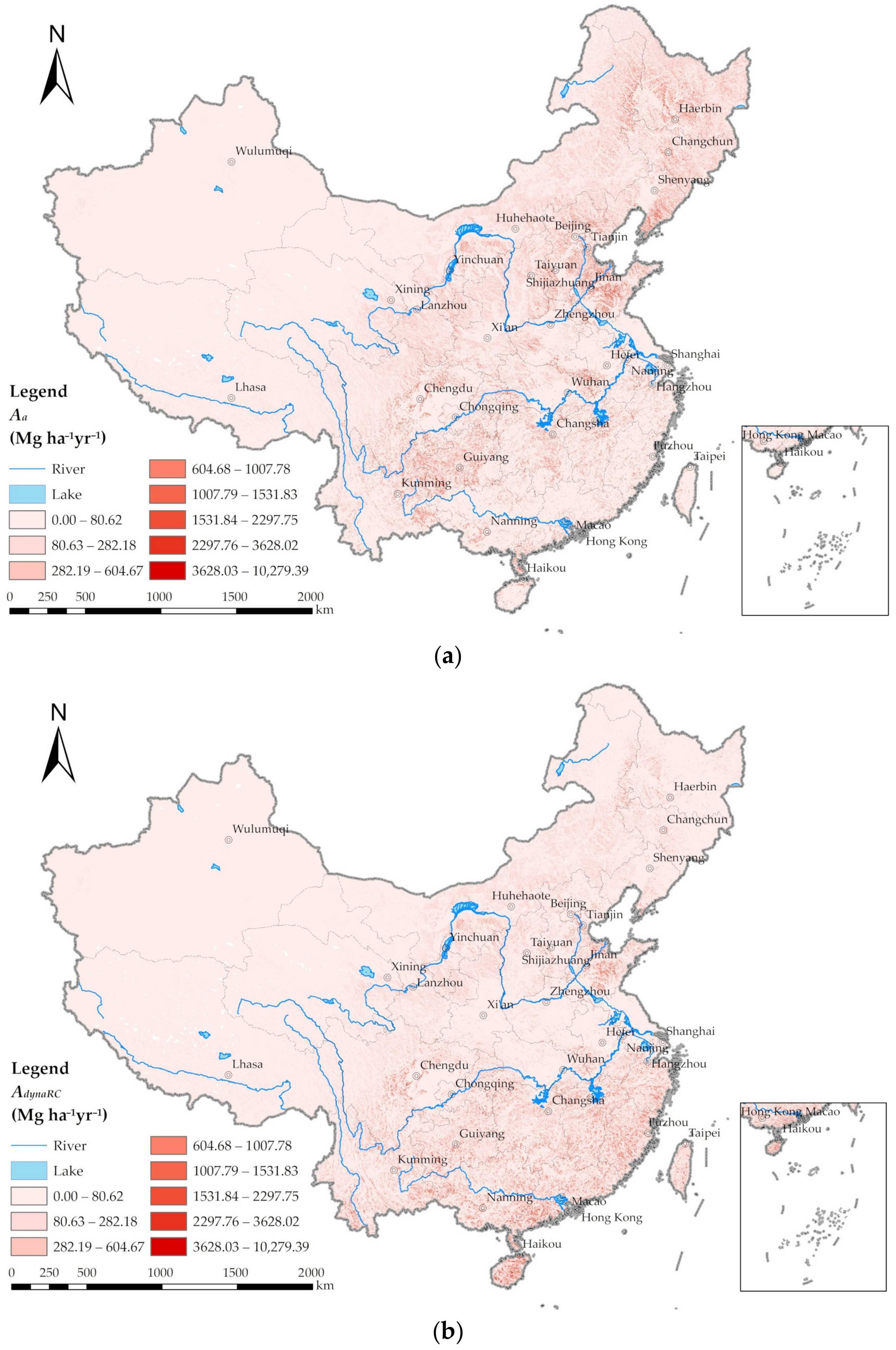Large-Scale Soil Erosion Estimation Considering Vegetation Growth Cycle
Abstract
1. Introduction
2. Data and Methods
2.1. Data and Study Area
2.2. Soil Erosion Estimation Model Considering Vegetation Growth Cycle
2.3. Uncertainty Analysis of Soil Erosion
3. Results
3.1. Calculation of Ra and Ca
3.2. Nationwide Soil Erosion
3.3. Soil Erosion after Köppen Climate Classification
4. Discussion
5. Conclusions
Author Contributions
Funding
Institutional Review Board Statement
Informed Consent Statement
Data Availability Statement
Acknowledgments
Conflicts of Interest
References
- Crosson, P. Soil Erosion Estimates and Costs. Science 1995, 269, 461–465. [Google Scholar] [CrossRef] [PubMed]
- Dent, D. Global Environment Outlook: GEO 4. Environment for development. United Nations Environ. Programme Sect. B State Trends Environ. 1987, 2007, 81–114. [Google Scholar]
- Pimentel, D.; Harvey, C.; Resosudarmo, P.; Sinclair, K.; Kurz, D.; McNair, M.; Crist, S.; Shpritz, L.; Fitton, L.; Saffouri, R. Environmental and economic costs of soil erosion and conservation benefits. Science 1995, 267, 1117–1123. [Google Scholar] [CrossRef]
- Zhao, X.L.; Zhang, Z.X.; Zhou, Q.B. Soil erosion actuality and its synthesis prevention countermeasures in China. J. Soil Water Conserv. 2002, 16, 40–43. [Google Scholar]
- Kaffas, K.; Hrissanthou, V. Computation of hourly sediment discharges and annual sediment yields by means of two soil erosion models in a mountainous basin. Int. J. River Basin Manag. 2019, 17, 63–77. [Google Scholar] [CrossRef]
- Dai, Q.; Yang, Q.; Han, D.; Rico-Ramirez, M.A.; Zhang, S. Adjustment of radar-Gauge rainfall discrepancy due to raindrop drift and evaporation using the Weather Research and Forecasting model and dual-Polarization radar. Water Resour. Res. 2019, 55, 9211–9233. [Google Scholar] [CrossRef]
- Wischmeier, W.H.; Smith, D.D. Predicting Rainfall Erosion Losses: A Guide to Conservation Planning; US Department of Agriculture: Washington, DC, USA, 1978.
- Renard, K.G.; Foster, G.R.; Weesies, G.A.; Mccool, D.K.; Yoder, D.C. Predicting Soil Erosion by Water: A Guide to Conservation Planning with the Revised Universal Soil Loss Equation (RUSLE); US Department of Agriculture: Washington, DC, USA, 1997.
- Feng, Q.; Zhao, W. The study on cover-Management factor in USLE and RUSLE: A review. Acta Ecol. Sin. 2014, 34, 4461–4472. [Google Scholar]
- Hara, F.; Achab, M.; Emran, A.; Mahe, G. Hydrological processes and water security in a changing world Study of soil erosion risks using RUSLE Model and remote sensing: Case of the Bouregreg watershed (Morocco). In Proceedings of the Hydrological Processes and Water Security in a Changing World, Beijing, China, 16 September 2020. [Google Scholar]
- Sahli, Y.; Mokhtari, E.; Merzouk, B.; Laignel, B.; Vial, C.; Madani, K. Mapping surface water erosion potential in the Soummam watershed in Northeast Algeria with RUSLE model. J. Mt. Sci. 2019, 16, 1606–1615. [Google Scholar] [CrossRef]
- Li, J.; Sun, R.; Xiong, M.; Yang, G. Estimation of soil erosion based on the RUSLE model in China. Acta Ecol. Sin. 2020, 40, 3473–3485. [Google Scholar]
- Yuan, L.; Zhou, Q. The application of cellular automata in simulating the spatial-temporal dynamic development process of soil erosion. Res. Soil Water Conserv. 2005, 12, 59–64. [Google Scholar]
- Wenwu, Z.; Bojie, F.; Yihe, L.; Liding, C. Land use and soil erosion at multiscale. Prog. Geogr. 2010, 25, 24–33. [Google Scholar]
- Dai, Q.; Zhu, J.; Zhang, S.; Zhu, S.; Han, D.; Lv, G. Estimation of rainfall erosivity based on WRF-derived raindrop size distributions. Hydrol. Earth Syst. Sci. 2020, 24, 5407–5422. [Google Scholar] [CrossRef]
- Xu, H. A Methodology of Soil Erosion Evaluation on Slope System. Earth Sci. 1997, 6, 652–655. [Google Scholar]
- Nunes, A.N.; Lourenço, L.; Vieira, A.; Bento-Gonçalves, A. Precipitation and erosivity in southern Portugal: Seasonal variability and trends (1950–2008). Land Degrad. Dev. 2016, 27, 211–222. [Google Scholar] [CrossRef]
- Loureiro, N.; Coutinho, M. A new procedure to estimate the RUSLE EI30 index, based on monthly rainfall data and applied to the Algarve region, Portugal. J. Hydrol. 2001, 250, 12–18. [Google Scholar] [CrossRef]
- Chen, M.; Voinov, A.; Ames, D.; Kettner, A.; Goodall, J.; Jakeman, A.; Barton, M.; Harpham, Q.; Cuddy, S.; DeLuca, C. Open web-distributed integrated geographic modelling and simulation to enable broader participation and applications (Position paper). Earth Sci. Rev. 2020, 207. [Google Scholar] [CrossRef]
- Wang, G.; Gertner, G.; Liu, X.; Anderson, A. Uncertainty assessment of soil erodibility factor for revised universal soil loss equation. Catena 2002, 46, 1–14. [Google Scholar] [CrossRef]
- Panagos, P.; Karydas, C.G.; Gitas, I.Z.; Montanarella, L. Monthly soil erosion monitoring based on remotely sensed biophysical parameters: A case study in Strymonas river basin towards a functional pan-European service. Int. J. Digit. Earth 2012, 5, 461–487. [Google Scholar] [CrossRef]
- Wischmeier, W.H.; Smith, D.D. Rainfall energy and its relationship to soil loss. Eos Trans. Am. Geophys. Union 1958, 39, 285–291. [Google Scholar] [CrossRef]
- Ferreira, V.; Panagopoulos, T. Seasonality of soil erosion under Mediterranean conditions at the Alqueva dam watershed. Environ. Manag. 2014, 54, 67–83. [Google Scholar] [CrossRef]
- Yang, X. Deriving RUSLE cover factor from time-series fractional vegetation cover for hillslope erosion modelling in New South Wales. Soil Res. 2014, 52, 253–261. [Google Scholar] [CrossRef]
- Angulo-Martínez, M.; Beguería, S. Estimating rainfall erosivity from daily precipitation records: A comparison among methods using data from the Ebro Basin (NE Spain). J. Hydrol. 2009, 379, 111–121. [Google Scholar] [CrossRef]
- Ballabio, C.; Borrelli, P.; Spinoni, J.; Meusburger, K.; Michaelides, S.; Beguería, S.; Klik, A.; Petan, S.; Janeček, M.; Olsen, P. Mapping monthly rainfall erosivity in Europe. Sci. Total Environ. 2017, 579, 1298–1315. [Google Scholar] [CrossRef]
- Wang, J.; Rich, P.M.; Price, K.P.; Wang, J.; Rich, P.M.; Price, K.P. Temporal responses of NDVI to precipitation and temperature in the central Great Plains, USA. International Journal of Remote Sensing. Int. J. Remote Sens. 2003, 24, 2345–2364. [Google Scholar] [CrossRef]
- Durigon, V.L.; Carvalho, D.F.; Antunes, M.; Oliveira, P.; Fernandes, M.M. NDVI time series for monitoring RUSLE cover management factor in a tropical watershed. Int. J. Remote Sens. 2014, 35, 441–453. [Google Scholar] [CrossRef]
- Baiamonte, G.; Minacapilli, M.; Novara, A.; Gristina, L. Time Scale Effects and Interactions of Rainfall Erosivity and Cover Management Factors on Vineyard Soil Loss Erosion in the Semi-Arid Area of Southern Sicily. Water 2019, 11, 978. [Google Scholar] [CrossRef]
- Koo, H.; Iwanaga, T.; Croke, B.F.; Jakeman, A.J.; Yang, J.; Wang, H.-H.; Sun, X.; Lü, G.; Li, X.; Yue, T. Position paper: Sensitivity analysis of spatially distributed environmental models-a pragmatic framework for the exploration of uncertainty sources. Environ. Model. Softw. 2020, 134, 104857. [Google Scholar] [CrossRef]
- Chen, C.; He, B.; Guo, L.; Zhang, Y.; Xie, X.; Chen, Z. Identifying critical climate periods for vegetation growth in the Northern Hemisphere. J. Geophys. Res. BioGeosci. 2018, 123, 2541–2552. [Google Scholar] [CrossRef]
- Wischmeier, W.H.; Smith, D.D. Predicting Rainfall-Erosion Losses from Cropland East of the Rocky Mountains: Guide for Selection of Practices for Soil and Water Conservation; US Department of Agriculture: Washington, DC, USA, 1965.
- Xie, Y.; Yin, S.Q.; Liu, B.Y.; Nearing, M.A.; Zhao, Y. Models for estimating daily rainfall erosivity in China. J. Hydrol. 2016, 535, 547–558. [Google Scholar] [CrossRef]
- Yin, S.; Xie, Y.; Nearing, M.; Wang, C. Estimation of rainfall erosivity using 5-to 60-minute fixed-interval rainfall data from China. Catena 2007, 70, 306–312. [Google Scholar] [CrossRef]
- Yan, Z.; Baoyuan, L.; Peijun, S.; Zhongshan, J. Crop cover factor estimating for soil loss prediciton. Acta Ecol. Sin. 2001, 21, 1050–1056. [Google Scholar]
- Qi, J.; Marsett, R.; Moran, M.; Goodrich, D.; Heilman, P.; Kerr, Y.; Dedieu, G.; Chehbouni, A.; Zhang, X. Spatial and temporal dynamics of vegetation in the San Pedro River basin area. Agric. For. Meteorol. 2000, 105, 55–68. [Google Scholar] [CrossRef]
- Cai, C.; Ding, S.; Shi, Z.; Huang, L.; Zhang, G. Study of applying USLE and geographical information system IDRISI to predict soil erosion in small watershed. J. Soil Water Conserv. 2000, 14, 19–24. [Google Scholar]
- McCool, D.K.; Foster, G.R.; Mutchler, C.; Meyer, L. Revised slope length factor for the Universal Soil Loss Equation. Trans. Asae 1989, 32, 1571–1576. [Google Scholar] [CrossRef]
- Liu, B.; Nearing, M.A.; Risse, L.M. Slope gradient effects on soil loss for steep slopes. Trans. Asae 1994, 37, 1835–1840. [Google Scholar] [CrossRef]
- Williams, J.; Nearing, M.; Nicks, A.; Skidmore, E.; Valentin, C.; King, K.; Savabi, R. Using soil erosion models for global change studies. J. Soil Water Conserv. 1996, 51, 381–385. [Google Scholar]
- Yaping, L.; Xiaoping, L.; Zhang, H.; Zezhong, L.; Wang, S. Soil erosion in Huaihe River Basin based on GIS and RUSLE:Exemplified by Shangcheng County, Xinyang City. Remote Sens. Land Resour. 2019, 31, 243–249. [Google Scholar]
- Chen, S.; Yang, X.; Xiao, L.; Cai, H. Study of Soil Erosion in the Southern Hillside Area of China Based on RUSLE Model. Resour. Sci. 2014, 36, 1288–1297. [Google Scholar]
- Panagos, P.; Borrelli, P.; Meusburger, K.; Yu, B.; Klik, A.; Lim, K.J.; Yang, J.E.; Ni, J.; Miao, C.; Chattopadhyay, N. Global rainfall erosivity assessment based on high-temporal resolution rainfall records. Sci. Rep. 2017, 7, 1–12. [Google Scholar] [CrossRef]
- Wuepper, D.; Borrelli, P.; Finger, R. Countries and the global rate of soil erosion. Nat. Sustain. 2020, 3, 51–55. [Google Scholar] [CrossRef]
- Panagos, P.; Borrelli, P.; Meusburger, K.; Alewell, C.; Lugato, E.; Montanarella, L. Estimating the soil erosion cover-management factor at the European scale. Land Use Policy 2015, 48, 38–50. [Google Scholar] [CrossRef]
- Panagos, P.; Ballabio, C.; Borrelli, P.; Meusburger, K.; Klik, A.; Rousseva, S.; Tadić, M.P.; Michaelides, S.; Hrabalíková, M.; Olsen, P. Rainfall erosivity in Europe. Sci. Total Environ. 2015, 511, 801–814. [Google Scholar] [CrossRef] [PubMed]
- Zhu, G.; Li, Y. Types and changes of Chinese climate zones from 1961 to 2013 based on Köppen climate classification. Arid Land Geogr. 2015, 38, 1121–1132. [Google Scholar]







| Data | Source | Time | Resolution | Calculation Purpose |
|---|---|---|---|---|
| Rainfall | Hourly data for rain gauges at 2168 stations | 2018 | T: hour S: 10 km | R-factor |
| Vegetation coverage | Terra satellite MODIS sensor data MODIS_DATA | 2018 | T: month S: 1 km | C-factor |
| Elevation | China DEM Data | T: annual average S: 10 km | LS-factor | |
| Soil | Global Soil Database | T: annual average S: 10 km | K-factor | |
| Land use | Land cover based on ESA Envisa satellite MERIS sensor data | T: annual average S: 10 km | P-factor |
Publisher’s Note: MDPI stays neutral with regard to jurisdictional claims in published maps and institutional affiliations. |
© 2021 by the authors. Licensee MDPI, Basel, Switzerland. This article is an open access article distributed under the terms and conditions of the Creative Commons Attribution (CC BY) license (https://creativecommons.org/licenses/by/4.0/).
Share and Cite
Zhuang, H.; Wang, Y.; Liu, H.; Wang, S.; Zhang, W.; Zhang, S.; Dai, Q. Large-Scale Soil Erosion Estimation Considering Vegetation Growth Cycle. Land 2021, 10, 473. https://doi.org/10.3390/land10050473
Zhuang H, Wang Y, Liu H, Wang S, Zhang W, Zhang S, Dai Q. Large-Scale Soil Erosion Estimation Considering Vegetation Growth Cycle. Land. 2021; 10(5):473. https://doi.org/10.3390/land10050473
Chicago/Turabian StyleZhuang, Hanchen, Yixin Wang, Hang Liu, Sijia Wang, Wanqiu Zhang, Shuliang Zhang, and Qiang Dai. 2021. "Large-Scale Soil Erosion Estimation Considering Vegetation Growth Cycle" Land 10, no. 5: 473. https://doi.org/10.3390/land10050473
APA StyleZhuang, H., Wang, Y., Liu, H., Wang, S., Zhang, W., Zhang, S., & Dai, Q. (2021). Large-Scale Soil Erosion Estimation Considering Vegetation Growth Cycle. Land, 10(5), 473. https://doi.org/10.3390/land10050473






